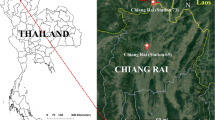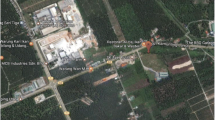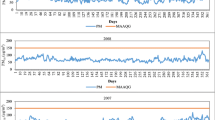Abstract
Frequent haze occurrences in Malaysia have made the management of PM10 (particulate matter with aerodynamic less than 10 μm) pollution a critical task. This requires knowledge on factors associating with PM10 variation and good forecast of PM10 concentrations. Hence, this paper demonstrates the prediction of 1-day-ahead daily average PM10 concentrations based on predictor variables including meteorological parameters and gaseous pollutants. Three different models were built. They were multiple linear regression (MLR) model with lagged predictor variables (MLR1), MLR model with lagged predictor variables and PM10 concentrations (MLR2) and regression with time series error (RTSE) model. The findings revealed that humidity, temperature, wind speed, wind direction, carbon monoxide and ozone were the main factors explaining the PM10 variation in Peninsular Malaysia. Comparison among the three models showed that MLR2 model was on a same level with RTSE model in terms of forecasting accuracy, while MLR1 model was the worst.



Similar content being viewed by others
References
Afroz, R., Hassan, M. N., Ibrahim, N. A., et al. (2003). Review of air pollution and health impacts in Malaysia. Environmental Research, 92(2), 71–77. https://doi.org/10.1016/S0013-9351(02)00059-2.
Afzali, A., Rashid, M., Sabariah, B., Ramli, M., et al. (2014). PM10 pollution: its prediction and meteorological influence in PasirGudang, Johor. Proceedings of the IOP Conference Series: Earth and Environmental Sciences, 18.
Bhattacharjee, H., Drescher, M., Good, T., Hartley, Z., Leza, J-D., Lin, B., Moss, J., Massey, R., Nishino, T., Ryder, S., Sachs, N., Tozan, Y., Taylor, C., & Wu, D. (1999). Section 1: Introduction. In Particulate matter in New Jersey. Princeton: Princeton University.
DOE Department of Environment. (2000). A guide to Air Pollution Index (API) in Malaysia. Ministry of Science, Technology and the Environment.
DOE Department of the Environment (2015). Malaysia Environmental Quality Report 2014. Ministry of Natural Resources and Environment Malaysia.
DOE Department of the Environment (2017). Air quality standards: new Malaysia ambient air quality standard. https://www.doe.gov.my/portalv1/en/info-umum/english-air-quality-trend/108. Assessed 24 Feb 2017.
Hassan, N. A., Hashim, Z., Hashim, J. H., et al. (2016). Impact of climate change on air quality and public health in urban areas. Asia Pacific Journal of Public Health, 28(2S), 38S–48S. https://doi.org/10.1177/1010539515592951.
Junninen, H., Niska, H., Tuppurainen, K., Ruuskanen, J., Kolehmainen, M., et al. (2004). Methods for imputation of missing values in air quality data sets. Atmospheric Environment, 38(18), 2895–2907. https://doi.org/10.1016/j.atmosenv.2004.02.026.
Liew, J., Latif, M. T., Tangang, F. T., et al. (2011). Factors influencing the variations of PM10 aerosol dust in Klang Valley, Malaysia during the summer. Atmospheric Environment, 45, 4370–4378.
Liu, P.-W. G. (2009). Simulation of the daily average PM10 concentrations at Ta-Liao with Box-Jenkins time series models and multivariate analysis. Atmospheric Environment, 43(13), 2104–2113. https://doi.org/10.1016/j.atmosenv.2009.01.055.
Neter, J., Wasserman, W., & Kutner, M. H. (1985). Applied linear statistical models: regression, analysis of variance, and experimental designs (2nd ed.). Homewood, Illinois: R. D. Irwin.
Norazian, M. N., Ahmad Shukri, Y., Nor Azam, R., Al Bakri, A. M. M., et al. (2008). Estimation of missing values in air pollution data using single imputation techniques. ScienceAsia, 34(3), 341–345. https://doi.org/10.2306/scienceasia1513-1874.2008.34.341.
Shaadan, N., Jemain, A. A., Latif, M. T., Mohd Deni, S., et al. (2015). Anomaly detection and assessment of PM10 functional data at several locations in the Klang Valley, Malaysia. Atmospheric Pollution Research, 6(2), 365–375. https://doi.org/10.5094/APR.2015.040.
Shaharuddin, M., Zaharim, A., Mohd Nor, M. J., Karim, O. A., Sopian, K., et al. (2008). Application of wavelet transform on airborne suspended particulate matter and meteorological temporal variations. WSEAS Transactions on Environment and Development, 4(2), 89–98.
Siwek, K., & Osowski, S. (2012). Improving the accuracy of prediction of PM10 pollution by the wavelet transformation and an ensemble of neural predictors. Engineering Applications of Artificial Intelligence, 25(6), 1246–1258. https://doi.org/10.1016/j.engappai.2011.10.013.
Ul-Saufie, A. Z., Yahaya, A. S., Ramli, N. A., Rosaida, N., Abdul Hamid, H., et al. (2013). Future daily PM10 concentrations prediction by combining regression models and feedforward backpropagation models with principle component analysis (PCA). Atmospheric Environment, 77, 621–630. https://doi.org/10.1016/j.atmosenv.2013.05.017.
Vinceti, M., Malagoli, C., Malavolti, M., Cherubini, A., Maffeis, G., Rodolfi, R., Heck, J. E., Astolfi, G., Calzolari, E., Nicolini, F., et al. (2016). Does maternal exposure to benzene and PM10 during pregnancy increase the risk of congenital anomalies? A population-based case-control study. Science of the Total Environment, 541, 444–450. https://doi.org/10.1016/j.scitotenv.2015.09.051.
WHO World Health Organization. (2006). WHO Air Quality guidelines for particulate matter, ozone, nitrogen dioxide and sulfur dioxide: Global update 2005, Summary of risk assessment.
Acknowledgements
We would like to acknowledge Malaysia Department of Environment (DOE) for providing data to accomplish this study.
Funding
We would like to extend our gratitude to Universiti Sains Malaysia for Fellowship Scheme and Malaysia Ministry of Higher Education for financial assistance.
Author information
Authors and Affiliations
Corresponding author
Rights and permissions
About this article
Cite this article
Ng, K.Y., Awang, N. Multiple linear regression and regression with time series error models in forecasting PM10 concentrations in Peninsular Malaysia. Environ Monit Assess 190, 63 (2018). https://doi.org/10.1007/s10661-017-6419-z
Received:
Accepted:
Published:
DOI: https://doi.org/10.1007/s10661-017-6419-z




